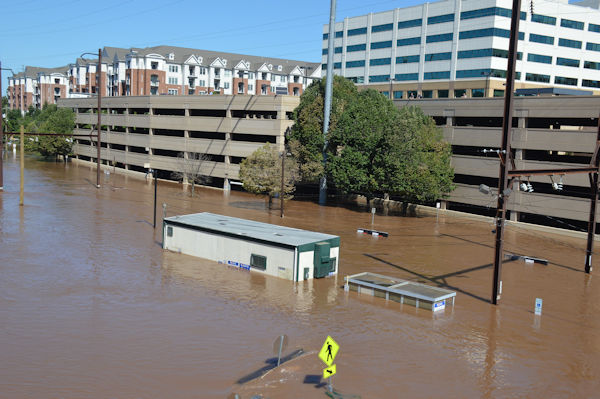SEJournal Online is the digital news magazine of the Society of Environmental Journalists. Learn more about SEJournal Online, including submission, subscription and advertising information.
 |
| Flooding from Tropical Storm Ida in Conshohocken, Penn. Photo: Michael Stokes, Flickr Creative Commons. Click to enlarge. |
TipSheet: Flood-Resistant Building Construction an Overlooked Environmental Story
By Joseph A. Davis
When floods destroy houses, as they did in recent weeks in Tennessee and, thanks to Hurricane Ida, in Louisiana and the Northeast, it makes news.
But to sharp-eyed environmental journalists, it shouldn’t be much of a surprise — some homes are a disaster waiting to happen.
Why it matters
The siting, design and construction of a house do much to determine whether it will survive floods.
And local and state governments play a big role in setting standards and limits that will keep the muck out of people’s living rooms.
Or not. There are parts of the U.S. where zoning and building codes are shunned or ignored.
There are also parts of the world where human habitation and dynamic water bodies have adapted and evolved to head off disaster.
Think of the houseboats of Amsterdam (may require subscription) or the floating fishing villages of Southeast Asia.
The backstory
Floods are more likely in some places than in others. In the United States, the subsidized federal flood insurance program is based on getting communities to restrict building in the flood plain.
Beyond the siting of homes, the way
homes and buildings are constructed
can limit or invite flood damage.
But beyond the siting of homes, the way homes and buildings are constructed can limit or invite flood damage.
A very common technique is putting the house on top of stilts — typically treated timber pilings, ideally driven so far into the ground that they rest on something solid like bedrock. Pilings may also be made of steel, masonry or steel and concrete.
Houses in flood-prone areas, or in areas with high water tables, may often be built without basements, on piers — often made of brick or masonry — which do not go below the surface of the ground but rather rest on it. Such houses are likelier to be dislodged or float away in a large flood.
In either case, if the bottom floor of the house stays above the highest level of floodwaters, there is less chance that the flood will cause damage inside.
Christopher Flavelle wrote about how construction affects flood damage in the New York Times Aug. 26 (may require subscription). He made the point that many siting and construction decisions are actually controlled by state and local governments via zoning and building codes.
Except that local governments in some parts of the country lack those same zoning and building codes, either because they don’t have the resources to enforce them or they simply don’t believe in them.
Story ideas
- What parts of your community are flood-prone? Are any that were considered less likely to flood now more so because of climate change? Are “flood plains” designated for these less probable events?
- Does your county have zoning regulations? Does it prevent construction of buildings in recognized flood plains? How many structures have been grandfathered or do not comply with zoning restrictions on flood plain construction?
- Does your county have building codes? Do these codes specify standards for flood-resistant construction? Does it go beyond simple elevation? How complete is the code? (Does it include things like gas, water, fill dirt and materials?)
- How many buildings in your area were built before the code came into effect? Are they grandfathered? Does your county enforce the code on additions and improvements?
Reporting resources
- American Society of Civil Engineers: A professional group that publishes model codes for flood-resistant construction.
- Federal Emergency Management Agency (FEMA): The federal agency that does most of the immediate response to flood disasters, runs the National Flood Insurance Program that produces flood maps and recommends flood-resistant building standards.
- Association of State Floodplain Managers: A professional association that takes policy positions and has many useful resources, including a list of state floodplain managers that may guide you to more insights about your locality or region.
- Local agencies: Visit and talk with people at your local agencies — the people who issue building permits, the municipal planning staff and the elected/appointed zoning board members.
- National Institute of Building Sciences: Through their Whole Building Design Guide program, the NIBS offers a publication, “Flood Resistance of the Building Envelope.”
Also check out “A Guide to Flood-Resistant Building Terms” (may require subscription) from David W. Dunlap of the New York Times.
Joseph A. Davis is a freelance writer/editor in Washington, D.C. who has been writing about the environment since 1976. He writes SEJournal Online's TipSheet, Reporter's Toolbox and Issue Backgrounder, and curates SEJ's weekday news headlines service EJToday and @EJTodayNews. Davis also directs SEJ's Freedom of Information Project and writes the WatchDog opinion column.
* From the weekly news magazine SEJournal Online, Vol. 6, No. 31. Content from each new issue of SEJournal Online is available to the public via the SEJournal Online main page. Subscribe to the e-newsletter here. And see past issues of the SEJournal archived here.














 Advertisement
Advertisement 



